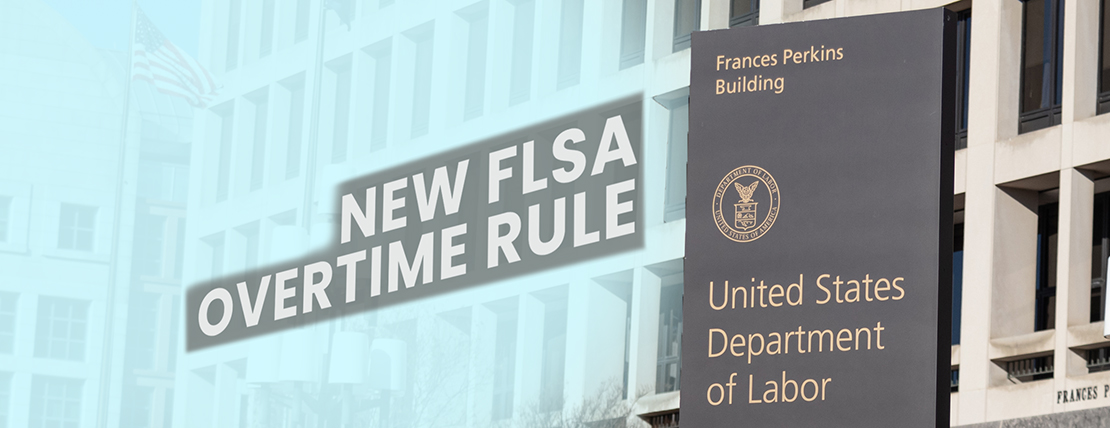- New salary threshold for overtime eligibility. The DOL proposed an increase to the minimum salary threshold for overtime eligibility under the FLSA to $55,068.
- Highly compensated employee exemption increased. The DOL is also proposing to increase the highly compensated employee exemption to $143,988 from $107,432.
- Legal challenges expected. Legal experts anticipate legal challenges to the rule because the increase (55%) is significant enough that it will be too burdensome on many employers. Some observers say there’s no evidence increasing the minimum salary requirement will result in fewer misclassified employees.
- Employers should be proactive. Though the rule is expected to face legal challenges, employers that take a wait-and-see approach may find themselves scrambling to implement the changes. At a minimum, employers should take the first step of determining which currently exempt positions are being paid below the proposed minimum salary level.
A federally proposed $20,000-plus increase in salaried workers’ eligibility for overtime — to $55,068 annual salary — has businesses facing the possibility of increased labor costs while rethinking their business model and staffing levels.
After several delays, the U.S. Department of Labor (DOL) on Wednesday proposed that increase for overtime eligibility under the Fair Labor Standards Act (FLSA). It would mandate overtime pay for most salaried workers earning less than $1,059 per week.
However, the proposal will very likely face a host of legal challenges. Although the new OT standard is not yet law, HR and legal experts recommend that businesses start preparing for a change.
In its release, the DOL announced in a notice of proposed rulemaking that the new threshold would restore and extend overtime protections to an estimated 3.6 million salaried workers.
Currently, the minimum salary level required for exemption is $35,568, which went into effect Jan. 1, 2020, under a DOL rule issued by the Trump administration in September 2019.
The minimum annual salary required to satisfy the Highly Compensated Employee (HCE) exemption is currently $107,432 and the DOL’s proposal would increase that to $143,988.
Proposed Threshold as Expected
Natalie Bare, a class action and employment law litigator for the Duane Morris law firm, said the DOL’s proposed overtime rule isn’t surprising, noting that it includes exactly what the DOL has long said it would include: an increase to the standard minimum salary level, an increase to the “highly compensated” employee total annual compensation threshold and an automatic process for future increases.
“There was speculation about potential changes to the job duties tests, so the absence of any changes on that front will allow employers to focus on the proposed changes to the salary thresholds,” Bare said. “The proposed increase for the minimum salary level is a very big jump, and this will have a major impact on employers across all industries that utilize the executive, administrative, and professional exemptions.”
If the OT changes are finalized, businesses will face significantly increased payroll costs, likely leading some to rethink their business model, reassess staffing needs and even consider changes to current employee benefit programs.
As a result, employers may have to reevaluate positions (particularly for first-line supervisors and managers), revise job descriptions, review pay practices, adjust payroll systems, modify pay statements and even consider changes to employee benefit programs, said Laurie DuChateau, who leads the U.S. Compliance Consulting Practice at Buck, a Gallagher company. And all of this would have to be done within a very tight timeframe.
Additionally, legal challenges are likely on the horizon, she said.
“Whether the new salary threshold is high enough to supplant the duties test will likely face legal challenge, as it did when a federal court blocked the Obama administration’s attempt to raise the threshold in 2017,” DuChateau said.
Lee Schreter, shareholder at Littler Mendelson P.C., echoed DuChateau’s sentiment.
“I would anticipate that any final rule will be challenged. Employers are just beginning to recover from COVID and its impact,” Schreter said. “This proposed rule will have a significant impact on small employers, nonprofits and entire industries such as hospitality, retail and healthcare.”
A ‘False Premise’
Schreter added that the salary levels are such that the congressionally established exemptions will be placed out of reach for many employers who employ individuals who will still meet the other exemption requirements outside of the proposed increase in the minimum salary.
“Additionally, the proposed salary levels will have a disproportionate impact on employers located outside large metropolitan areas,” she said, adding that the indexing proposal should again be rejected.
“This is a blatant attempt by DOL to avoid engaging in notice and comment rulemaking on any future salary increases, assuming DOL even has the authority to enact any minimum salary requirement,” she said.
“This rulemaking is based on a false premise — that a higher salary is necessary to ensure employees are properly classified as exempt,” Schreter said. “There is no evidence that increasing the minimum salary requirement will result in fewer misclassified employees. What the increased salary level will do is put lawfully available exemptions out of reach for certain employers.”
Erika Johnson, director, work, rewards & career at WTW, said that while no changes to the duties test were introduced, the proposed salary threshold will be a big change for most employers, representing a 55% increase over the current threshold.
Additionally, Johnson noted the proposed rule allows for an automatic review and increase of the threshold every third year. Historically, critics of the FLSA have cited the law’s deficiency in keeping the threshold relevant and tied to actual salary levels observed in the market, and when changes do occur, they are unmanageably large and burdensome.
“If the proposed rules are finalized, this auto-escalation provision will enable employers to anticipate and adequately prepare for future threshold changes,” she said.
There are some groups of salaried employees, most notably teachers, who could qualify under the salary standards but have been ruled ineligible for overtime pay.
Johnson also noted that the higher salary thresholds may not affect employers in states where the thresholds already exceed the new federal thresholds. For example, the California salary threshold is $64,480 per year, New York thresholds range from $55,341 to 58,500 per year.
According to Johnson, regardless of what steps employers have taken in the past, they will need to examine the effects of the new thresholds and rules on their pay practices to ensure compliance, assuming that these proposed regulations will take effect 60 days after the publication of the final rule.
“This may include training for newly non-exempt workers on appropriate timekeeping, adjustment of payroll or timekeeping systems, and compensation reviews for exempt employees below the new threshold,” she said.
Action Steps for Employers
Buck’s DuChateau offered some steps for employers to prep for the new OT world, including:
- Review employees in the bubble and determine whether to raise their salary to meet the new thresholds or convert them to non-exempt status. Consider cost implications as well as whether reclassifying employees to non-exempt could negatively impact morale or affect benefits.
- Develop employee communications to advise employees about changes to their compensation and what, if any, new responsibilities come with the changes.
- Provide advance notice of wage changes to employees as state or local laws may require.
Duane Morris’ Bare said that now that the proposal is here employers should begin planning their response to the anticipated increase, since the process of evaluating classification status and making decisions about whether to increase salary or reclassify can take substantial time and effort.
“The rule may, of course, face legal challenges that could delay it becoming final. But employers that take a wait-and-see approach may find themselves scrambling to implement the changes,” she said. “At a minimum, employers should take the first step of determining which positions they currently have classified as exempt and paid a salary less than the proposed minimum salary level.”
Upon publication in the Federal Register, the notice of proposed rulemaking will be open for public comment for 60 days before the DOL publishes the final rule.
Editor’s Note: Additional Content
For more information and resources related to this article see the pages below, which offer quick access to all WorldatWork content on these topics:







